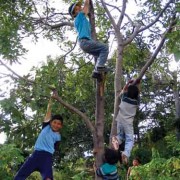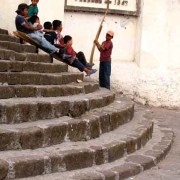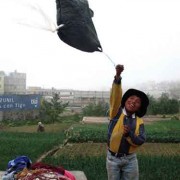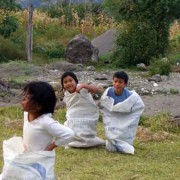Culture Unshocked: Toys and Play
written by Ana Flinder
 Not long ago, while perusing the endless tables piled high with used North American clothes at the Saturday paca market in La Antigua, I found a little T-shirt that caught my eye. It was about the right size for a 5 year old, and on it read “I want it— You buy it for me— Got it?” Now, why anyone would manufacture such a thing, or who would buy it, is a complete mystery to me, but it certainly was thought-provoking.
Not long ago, while perusing the endless tables piled high with used North American clothes at the Saturday paca market in La Antigua, I found a little T-shirt that caught my eye. It was about the right size for a 5 year old, and on it read “I want it— You buy it for me— Got it?” Now, why anyone would manufacture such a thing, or who would buy it, is a complete mystery to me, but it certainly was thought-provoking.
It brought to mind being in a giant Toys R Us-type mega-toy store, the pungent smell of plastic reaching toxic levels, and hearing tiny voices demanding, insisting, badgering and whining for the toys they wanted. I don’t frequent stores like that in the States, but on my last visit there, one could witness the same kind of whining insistence in grocery stores, on the street, in malls. It’s the attitude that comes through with the voice.
I saw that shirt, and I thought, “What a North American thing.” But for all I know that kind of dissatisfied, entitled insistence among children is also a European and Canadian thing. I rather suspect so. It certainly isn’t a Guatemalan thing. Not in the least. Gracias a Dios!
I look around the vast used-clothing market and see four Guatemalan children playing fútbol with an old empty juice bottle for a ball. And others, who laughingly compete to see who can yell the loudest as they imitate their parents calling out “barata, barata!! Meta la mano!, solo un billete.” (It must be said that the whole issue of working children in Guatemala is another matter, beyond the scope of this writing, and that there exist some horrendous conditions in some places. But I have seen working children who take every opportunity to play at work, and who seem happier than many privileged “Western” children I have known. And, having not spent time in the poorest parts of Guatemala City, I cannot say if my observations apply to those places.)
And as I go on in the next days I keep my eyes open, and I remember. I remember seeing children playing in the markets on many occasions: boys using the shoes that their family is selling at the paca to play catch with; a boy and his little sister at the bustling wholesale vegetable market in Zunil flying the kite that he had made from a leftover string attached to an old plastic bag; and the 10-year-old fish seller, finally off work, filling a plastic bottle with marbles with a huge grin on his face. Yes, they are working children, but there always seems to be time for play. And I have certainly never overheard any one of those market children whining that they want a toy or whining to get off work so they can go and play.As I walk through the main streets and the neighborhood side streets of Panajachel and other small towns, I always see children playing in groups. Morning, afternoon, and in the safe dark of evening, little groups of boys and girls play fútbol, race, play hide and seek.
It seems to me that most of the children I see here in Guatemala live with a level of freedom that hardly exists any more in the U.S. And it seems that this is made possible by a number of factors: one, the streets and markets are safe, safe because, for them, they are full of aunts, uncles, grandparents and family friends. The sense of safety that most children here have is due to the fact that there are always relatives around —and they come in all ages.There are always playmates, too. And I mean always. Many children have big extended families with many siblings and cousins to play, all living in the same town. Not only that, but sharing seems to come naturally. After all, if there are any toys, they’re a lot more fun with someone to play with.
What do they need toys for anyway? They’ve got sisters, brothers, cousins, grandparents, uncles, aunts. And if a child has an imagination, there’s hardly ever a lack of toys. Walking along the shore of Lake Atitlán, I see that the local children have no qualms about turning the plentiful flotsam into toys. On one stroll I noticed a group building a little house together. They framed it in with popsicle sticks, used a styrofoam plate for a roof, plastic detergent bags for rugs inside, and were having a great time planting twigs for the garden outside, and watering the garden with a styrofoam cup. A bit farther on, their big sister had filled a small plastic water bottle and a piece of broken hose with sand to make a play torch—and was happily holding it up and proclaiming herself the winner of the antorcha race.
Then again, when there’s no garbage available to make toys out of, there are always the tools of work, as when children on the shore have joined their father who has brought down a pile of plastic costal bags to fill up as he harvests sand and pebbles from the shore. These, it turns out, are perfect for climbing into to have a jumping race with your cousins. Or when several little cousins crawl through the “tunnel” made by boards drying in the sun outside the carpenter’s taller.

Remnants of Semana Santa decorations become the perfect vehicle for sledding down the church steps with friends. (photo: Victoria Stone)
Once while traveling through the backwoods of Chiapas, Mexico, I walked through tiny encampments of indigenous people who were the poorest I’d ever seen, living in little dirt-yard shacks amid sparse vegetation. I noticed that the slack-eyed children had not a toy in the world. Tin cans in the garbage piles had not even become wheels to pull on a string, neither had rags become dolls. And I remembered the saying, “Of the many kinds of poverty in the world, the most tragic is poverty of the imagination.” This may be a type of poverty shared by “Western” children, but thankfully here in Guatemala, imagination, inventiveness and play are alive and well.


